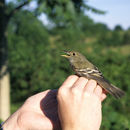en
names in breadcrumbs


A small (5 ½ inches) flycatcher resembling several related species in the genus Empidonax, the Acadian Flycatcher may best be separated from its relatives not by appearance, but by its ‘pit-see!’ song. Physical field marks include a green-gray body, white eye ring, pale breast, thin bill, and white wing bars. Male and female Acadian Flycatchers are similar to one another in all seasons. The Acadian Flycatcher is a more southerly breeder than most of its relatives, being found in summer in extreme southern Canada and across much of the eastern United States from New York south to Florida and west to Texas. Least Flycatchers spend the winter in Central and South America, although identifying this species’ in much of its winter range is difficult due to its similarity to other related species. Acadian Flycatchers breed in mature deciduous forests and, in parts of the southeastern U.S., in swamp forests dominated by bald cypress. On migration, this species enters younger, more open woodland and forest edges. In winter, Acadian Flycatchers inhabit humid tropical forests. This species primarily eats insects. In northern forests in summer, Acadian Flycatchers are most likely to be seen perching in the forest canopy while gleaning insects from leaves. Even when active, however, the Acadian Flycatcher is a difficult bird to identify. Learning this species’ song is crucial to separating it from its relatives, and silent birds are frequently impossible to identify in areas with multiple Empidonax species. Acadian Flycatchers are primarily active during the day.